Don't wanna be here? Send us removal request.
Text
This made me really want to watch Pariah! From what I saw, it seems like such a sensitive portrayal of intersectional identity, which is something that is so rarely accounted for in the media. I was interested in the idea of "ideologial conceptions of positive" that you brought up in your video. I think a lot of queer-related content is policed based on this framework, which I found quite reductive and frustrating. Pariah's choice to embrace and expand upon stereotypes rather than rejecting them altogether is a way to move past, producing more authentic stories in the process.
@theuncannyprofessoro
Pariah - Dee Rees (2011)
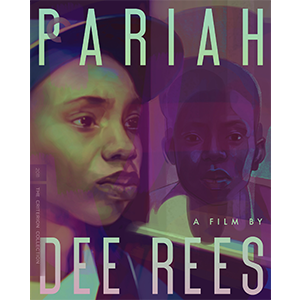
Engaging with film and media gives the public an opportunity to get to know people, places, and identities that they wouldn’t necessarily encounter in their own lives. Because of this, there are great steaks in the way that we represent people, particularly those who have been oversimplified, minimized or left out of stories completely. There are hugely necessary conversations happening about representation in film, the goal being to humanize people and refrain from perpetuating negative stereotypes that hold back representational progress. But what do we mean when we say “positive representation” and “positive imagery”? Do stereotypes always equate to negative representation? Dee Lee’s 2011 film Pariah breaks down some of the rules we have created about representation and shows us characters that expand stereotypes rather than rejecting them completely.
Pariah tells the story of 17 year old Alike coming to terms with her lesbian identity, navigating her queerness in the world of high school dating as well as in her religious and homophobic household. Alike’s best friend Laura – butch, sexy, confident, and much more romantically and sexually experienced than Alike – is attempting to help Alike break out of her shell and meet someone. Laura has not spoken to her mother in months and is living with her sister, working to support them, and attempting to get her GED so she can take on more responsibility. I find Laura’s story and her friendship with Alike to be really compelling and significant surrounding conversations of queer representation. Laura and Alike’s friendship is perfectly balanced with tenderness and tough love. When Alike decides that getting a strap-on would benefit her “image”, she goes to Laura and asks her to get one for her. Laura lovingly laughs at Alike and without question agrees to help. They stand together in the mirror as Alike reluctantly tries it on, Laura cheering her on and reassuring her that she looks good. There is something that is very sweet about this moment, evoking the innocence of a coming-of-age friendship, awkwardly helping each other navigate the constant newness and uncharted territory of their teenage lives. We continue to see moments like this where Laura and Alike, who are both forced to harden themselves to manage the intensity of their family lives, soften up with each other. When Alike starts having a romantic relationship with Bina, a neighborhood girl who her mom forces her to start hanging out with to keep her from Laura, Laura comes to Alike with concern about drifting apart. She tells Alike, “I just want to get this off my chest. I’m glad she makes you happy. I’m happy for you. Cause I love you.” You can tell on Alike’s face that she is shocked to hear this. You can see on Laura’s face that this kind of expression is difficult for her. The real turning point in our understanding of Laura is the first time we meet her mom. Laura comes to see her and nervously attempts to get everything out. She tells her she got her GED and that her and her sister are working hard and making her proud. Her mother says nothing before shutting the door and going back inside. This is a really significant moment for Laura because up until this point she has never seemed to care what anyone thought of her. We realize here that there is one person who she will always be trying to impress. She stands outside her mothers door panicked and in tears. All she wanted was her recognition and approval.
I think a lot of concerns around queer representation frame the existence of stereotypes as inherently negative, fighting for queer characters who are doing something different. In his book, Female Masculinity, Jack Halberstam questions what we really want out of queer characters and what gets to be positive representation. “Positive images, we may note, too often depend on thoroughly ideological conceptions of positive (white, middle-class, clean, law-abiding, monogamous, coupled, etc.)” Laura’s character rejects the idea that positive representation of queerness has to be those things; representation of Black female masculinity is such an important subversion from the power and respect that is glued to images of white male masculinity. She holds with power and strength her identity as butch lesbian of color: she is tough, self-assured, popular with femmes, and uninterested in what anyone thinks about her. She is also not diminished to those qualities alone. She is sensitive, intelligent, complicated, she takes her life seriously and has a thoroughly explored, trusting and deep friendship with Alike.Without the moments of vulnerability and openness I described, Laura may have been passed off as a side character, and therefore reduced to some of her more surface level qualities. The times in which stereotypes are negative are when they are diminishing and when characters are not allowed real depth and character development. Halberstam explores the most common queer media stereotypes, “the butch” and “the queen,” pushing back on the assumption that when we encounter butches and queens we are encountering a homophobic narrative. “It is important to judge the work that the stereotype performs within any given visual context-accordingly, if the queen or the butch is used only as a sign of that character's failure to assimilate, then obviously the stereotype props up a dominant system of gender and sexuality. But often the butch or the queen exceeds the limits of representation imposed by the law of the stereotype and disrupts the dominant systems of representation that depend on negative queer images." Butchness, framed simply as a stereotype, denies it any validity as a true and authentic identity.
Laura’s character is a strong example of positive queer representation because she owns her identity and breaks down walls that are so often formed around characters like her. Her character owns a stereotype without presenting it as a failure to be more. The problem with representation in film is that certain characters are not afforded the opportunity to display their “more”. Framing stereotypes as a form of negative representation can be a dangerous narrative. Leaving butchness out of queer stories to avoid stereotypicality depends on butch identity as a negative queer image. Instead of rejecting stereotypes wholly, we should be doing work to make sure we give our minority characters the opportunity to be known fully, to have flaws, and to still be cared about.
Works Cited:
Halberstam, Jack. Female masculinity. Durham (Grande-Bretagne): Duke University Press, 2018.
@theuncannyprofessoro
7 notes
·
View notes
Text
Liv!!! I loved this. You employed so many creative devices within your video that really drew me in. First off, I felt you it was a particularly insightful feat of analysis to frame the acts of the film around a female orgasm. This felt in line with your focus on sexual representation in media and how said representation often fails to account for the experience of women. Your allusions to filmic history were equally intriguing and I really enjoyed your use of archival footage. The part where you refer to the audience watching Leo watch Nancy spoke to the voyeuristic nature of film-viewing and the ways in which this particular film subverts that.
@theuncannyprofessoro
Good Luck to You, Leo Grande (2022) dir. Sophie Hyde

Good Luck to You Leo Grande (2022) is an unconventional romantic comedy, sometimes even described specifically as a “sex comedy,” directed by Sophie Hyde. The film consists primarily of intimate conversations and sex between Nancy Stokes, a neurotic older woman with little sexual experience, and Leo Grande, a charismatic young sex worker whom Nancy hires to explore her sexuality. It stars the incomparable Emma Thompson and Daryl McCormack, sure to be a star-on-the-rise, who bring to life a witty, provocative screenplay written by Katy Brand. In my video essay, I employed a narrative analysis to discuss the film’s unique four-act structure against the female sexual response cycle. I also observed Hyde’s subversive use of The Gaze in specific scenes of the film. In this analysis, I will use genre studies to compare Good Luck to You Leo Grande to the typical conventions of the Romantic-comedy, then discuss the racial representation of the film against the oppositional gaze.
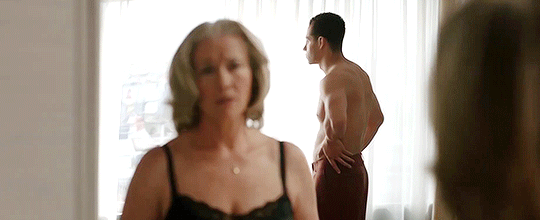
Subverting or Evolving the RomCom?
The label of RomCom does not perfectly describe Good Luck to You, Leo Grande, but it also doesn’t not describe it. On one hand, it is romantic, flirtatious, and sexy; it is also comedic, approaching the complex moral qualms of its subject matter with honesty and levity. On the other hand, these same moral themes and Hyde’s more artistic ambitions, such as setting most of the film in one location and the seeming lack of plot, have made it all too easy for viewers to label the film as a work of cinema more “elevated” than a typical RomCom. This assumption not only demeans the hundreds of films in the RomCom genre as somehow “low-brow,” but is also simply a misunderstanding of the romantic comedy as a genre.
In “Genre: The Conventions of Connection,” Leo Braudy boldly defends the cultural importance of genre films, a category which the romantic comedy falls into. He writes “Genre films, in fact, arouse and complicate feelings about the self and society that more serious films, because of their bias toward the unique, may rarely touch” (664). Romantic comedies, at their core, are a digestible way to attempt to make sense of the nebulous concept of love, and the complicated, vulnerable, and often unspoken topic of sex. Good Luck to You, Leo Grande, honors this true nature of the romantic comedy, complicating it one step further by discoursing sex work and daring to represent the desire of an older woman.
Thus the unique “couple” at the heart of Hyde’s film is what sets it apart the most from other RomComs. Popular, mainstream heterosexual romantic comedies nearly always star a man and woman who each absolutely epitomize the beauty standard of the time, and are either young and unstoppable or adults in their thirties with fun yet respectable dream jobs. On romantic comedies, Betty Kaklamanidou writes “One could even argue that the utopian rom com world is the ideal incarnation of a fantasy society where difference is celebrated rather than exorcized, and where every person can truly be equal to the next” (150). It can be said, then, that in this fantasy world, only the most conventionally beautiful people are deserving the most incredible experiences. Good Luck to You Leo Grand abandons this idea of a perfect, utopian world, and exists in a version of the real world. Though unmistakably beautiful, the simple fact of Nancy’s age makes her a subversive RomCom heroine; she is simply an ordinary woman who happens to be older. Leo, too, greatly complicates the squeaky-clean RomCom formula merely in his occupation of a sex-worker. Unlike a certain film known as Pretty Woman and others of its kind, Leo does not need to be “saved” from his lifestyle. In fact, it is Nancy who is framed as needing “saving” and revitalization (something which I will address more in a bit).
Finally, Good Luck to You Leo Grande subverts the romantic comedy in that it does not end as a romance at all! Hyde does not rely on some forbidden romance between Nancy and Leo to keep her film interesting. They begin their relationship as something strictly sexual then form a strong platonic, friendly bond, these two kinds of connection consistently distinguished from romance throughout the film. Still, their once-in-a-lifetime friendship follows the prototypical trappings of a RomCom romance: the strange meet-cute, the rough patch, the betrayal, and the reunion.
With all this in mind, I ultimately find that Good Luck to You Leo Grande is not a “subversive” or “elevated” RomCom, but simply a sign that female filmmakers are expanding the previously limited notions of what a RomCom can be.

Laughing Through Color Once Again
There is one unfortunate but crucial aspect of many RomComs that must be discussed within the text of Good Luck to You Leo Grande: the Other. Due to the fact that older women and sex workers are two identity categories which are almost never explored in depth, both stars of the film are relative “Others” within the RomCom canon. Still, the factors of race and class are largely at play within the dynamic between Nancy and Leo.
Leo is a biracial sex worker. Nancy is a white woman hiring Leo for her satisfaction, to feel “young” again. Racial difference is hinted at but not explicitly addressed in the film, though other forms of oppression such as class and misogyny are discussed at length. With these facts in mind, how is the film any different than so many others in which a character of color is used for the development of a leading white character?
I am not the person to provide a sufficient answer to this question. However, I do feel like this generalizing comparison can err on the side of implying that sex work is demeaning, unwanted work. This is a perception of sex work that the film spends so much time and dialogue trying to refute. Leo is proud of his work; he chose this line of work. There are also so many subtle, intersecting power dynamics at play between Leo and Nancy that make it difficult to decipher who is necessarily “in control” in the many sexual scenarios of the film. While Nancy hired Leo and has the ability to refuse his pay or give a negative rating, Leo has much more sexual experience than her, acting as her kind and willing guide as she is in an incredibly vulnerable state.
Still, I think the way that Leo is portrayed and the “colorblind” approach to his race seems to be reinventing the wheel of the “palatable” Other. As Kaklamanidou writes, “This deceptive colour blindness applies to an extent to the Hollywood industry which attempts to metamorphose its ethnic stars into profitable commodities by enhancing and taking advantage of their appealing ethnic characteristics and diminishing and/or defusing those traits that may emphasize
their ‘other’ side” (141). This seems to be a very fitting description of Leo, characterized as a “palatable” Black sex worker. Leo seems to be economically stable and presents himself as classy, presumably appealing to wealthier clients. He also had the ability to choose sex work. Would Leo be portrayed with the same amount of charm and sex appeal if this were not the case?
Finally, the portrayal of postmenopausal feminine sexual desire through the character of Nancy is, undoubtedly, revolutionary and subversive. The film has received several positive reviews from (notably white) older women who never thought they’d be able to see themselves in a RomCom. But the progressive representation in this film only extends to white women. As hooks writes, “Most of the black women I talked with were adamant that they never went to movies expecting to see compelling representations of black femaleness. They were all acutely aware of cinematic racism-its violent erasure of black womanhood” (310). Nearly thirty years after the publication of hooks’ piece, this sentiment has sadly changed very little, and Good Luck to You Leo Grande, though a positive step for some, is no exception. Ultimately, there is no other film I can think of that is quite likeSophie Hyde’s Good Luck to You Leo Grande. Though it is definitely imperfect, it makes me excited for the future of RomComs.

Works Cited
Braudy, Leo. "Genre: The conventions of connection." Film theory and criticism 6 (1999): 663-679.
Good Luck to You, Leo Grande Directed by Sophie Hyde, performances by Emma Thompson and Daryll McCormack, 2022. Hulu.
Hooks, Bell. "The oppositional gaze: Black female spectators." Black American Cinema. Routledge, 2012. 288-302.
Kaklamanidou, B. (2013). Genre, Gender and the Effects of Neoliberalism: The New Millennium Hollywood Rom Com (1st ed.). Routledge.
4 notes
·
View notes
Text
Hi Bea! I loved your video essay. The Watermelon Woman is one of my favorite movies, so I'm glad to see it get some shine. You make such an interesting point about the film's focus on who is "the producer and consumer of media." Minority groups often have to contextualize themselves through the media that has been provided to them. Though this can be limiting, it is also a means of excavating self, and more broadly, history, from unchecked places. Given that film is interested in 20th century Hollywood, the speculative is used as a creative jumping off points to create new modes of representation. Dunye's ultimate act of resistance is one of autonomy, making her own art in response to the media that she has consumed.
@theuncannyprofessoro
The Watermelon Woman: Queer representational strategies as possibility

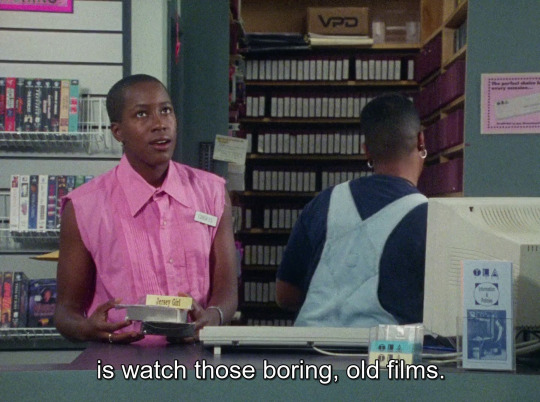
Cheryl Dunye’s The Watermelon Woman (1996) made history as the first feature film written and directed by a Black lesbian–but the film knows this and extensively explores its appellation as the “first of its kind,” a title Dunye simultaneously treats with frustration and reverence. It’s strikingly self-aware, funny, and inventive, a semi-autobiographical story about Cheryl, a video store clerk and chronically single filmmaker who decides to make a documentary on a mysterious Black actress from the 1930s pigeonholed into playing “mammy” roles who appears in the credits of a film called Plantation Memories simply as “The Watermelon Woman.” It’s a movie about movies! “I am a Black lesbian filmmaker who's just beginning,” Cheryl says, and here the thesis of the movie exhumes itself. The text demonstrates a preoccupation with the power of identity as a representational strategy through imagery and insists on its existence, the Black lesbian gaze resisting hiddenness behind the camera and crafting a visible narrative powered by the excavation of archival memory, the straddling of truth and representations of truth, of real and imagined. Dunye’s filmmaking mirrors her own life while the fictionalized version of herself seeks her own image in the black-and-white static of footage nearly lost to history. The Watermelon Woman chronicles the myriad of interconnected dynamics between art and real life–its awareness of the ways it is speaking about and to itself is demonstratively pointed, with Cheryl often speaking directly to the camera about her project and desire to tell Fae’s story.

Fae Richards, the eponymous Watermelon Woman, symbolizes the Black queer archive that future generations of Black queer filmmakers like Cheryl strive to hold within their canon, and as Cheryl interviews subjects for her documentary on Fae and digs through archives she finds proof not only of Fae’s existence but of her queerness¹. She discovers that Martha Page, the white director of Plantation Memories, and Fae were in a relationship, all the while navigating her own dating life, getting entangled with a white video store patron named Diana, much to her best friend Tamara’s dismay. The ways Cheryl’s relationship with Diana parallels Fae and Martha’s excavates the possibilities and challenges of “race relations” within queerness and the ways white lesbianism often possesses an objectifying curiosity with Blackness. The film’s theoretical standpoint as a piece of media that presents a representational theory of Black queerness pointing out gaping holes in the so-called canon is made imminent by some of its casting choices–cultural critic and infamous haver of weird opinions Camille Paglia appears as a parody of herself and a mouthpiece for white feminist film theory offering a misguided take on the “mammy” sterotype, and love interest Diana is played by Guinevere Turner, cowriter and star of the 1994 lesbian film Go Fish. The Watermelon Woman theorizes that sexuality and race are mutually constitutive and through the production and reception of representational imagery this interrelation is complicated by the relationship between the creator and the recipient of an image–Cheryl is a lover of film as much as she is a filmmaker and a large portion of her desire to tell stories about the complexity of being a Black woman who is many things at once comes from her desire to consume these stories.
Jack Halberstam’s “Looking Butch: A Rough Guide to Butches on Film” bifurcates queer imagery into “positive” and “negative,” necessarily locating “butch” as a visual identity located in media representations in one of two pathologies². Butchness in film is often leveraged to be emblematic of non-normative female sexuality in a way that is easily visually understood, and as a result, butch lesbians in film have more often than not functioned to be objects rather than subjects of inquiry. Halberstam posits that the debate around positive and negative images often returns to early feminist film criticism calling for “positive representations,” categorically rejecting depictions that could be received in their full complexity as anything other than “good.” Halberstam complicates the idea of a positive image by postulating that this desire for queer imagery imbedded with messaging that campaigns for itself places “the onus of queering cinema squarely on the production rather than the reception of images.” The Watermelon Woman explores how cinema is queered both through the production and reception of images; Cheryl watches Plantation Memories for the first time, she reads the queerness in it and it becomes a queer text because of her viewing, then when it is revealed that The Watermelon Woman and the film’s white director were in a relationship, her read is validated. Cheryl’s onscreen presence as a butch lesbian is overtly queer and her and Tamara’s open discussion of lesbianism as well as an intimate sex scene between Cheryl and Diana underscore this film’s goal of moving beyond the implicit in representation, further informing the lesbian lens with with Cheryl uses to analyze and interpret films like Plantation Memories.

Plantation Memories is not a real film, but it might as well be as it represents the startling politics of race films of its time where the white Scarlet O’Hara-type starlet weeps in the arms of the nurturing Black woman with such vigor that it’s hard not to believe in its existence. The consequence of the effects films like it produced continue to be felt in strategies of representation and Fae Richards does not represent an easily “positive” image of queerness–instead occupying a space in the troubling tradition of the racialized dominant images of Black women in film–yet Cheryl recognizes herself in Fae’s performance partially because it is so fraught. She identifies in her relationship with Diana a similar dynamic to Fae Richards and Martha Page, who only cast her lover in highly stereotyped and racially singular roles, where her lesbianism and Blackness are at slight odds with one another when in a relationship with a white lesbian who can relate to her based on only one of those central tenets and displays a voyeuristic and ultimately isolating interest in the other one. The Watermelon Woman argues for complexity beyond “positive” and “negative” imagery and constructs a Foucauldian reverse discourse where negative imagery can be positively productive when viewed critically and rethought. The film invests in the prospect that art can be a two-way conversation and that by beholding representational images, we project our possibilities onto it. The image on the screen dims and the reflection of the audience is left peering back at itself--Dunye holds onto this moment and treats it with tenderness, imbuing this empty space with hope.
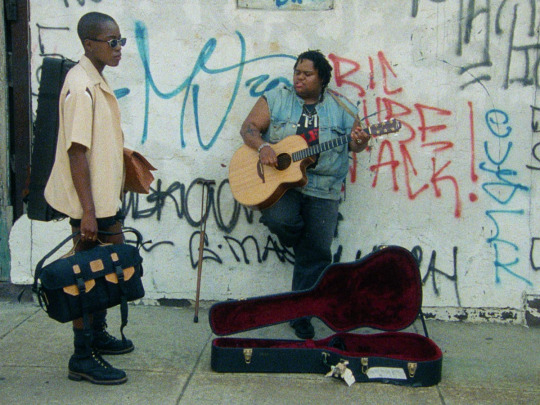
@theuncannyprofessoro
Ratnarajah, Anoushka. “Indisputably Real: Cheryl Dunye’s the Watermelon Woman.” Out On Screen, August 6, 2021. https://outonscreen.com/blog/2020/news/indisputably-real-cheryl-dunyes-the-watermelon-woman/.
Halberstam, Jack. Looking Butch: A Rough Guide to Butches on Film" In Female Masculinity, 175-230. New York, USA: Duke University Press, 1998. https://doi.org/10.1515/9780822378112-008
18 notes
·
View notes
Text
Zola: Digital Storytelling and Racial Performance
“Y'all Wanna Hear A Story?...”
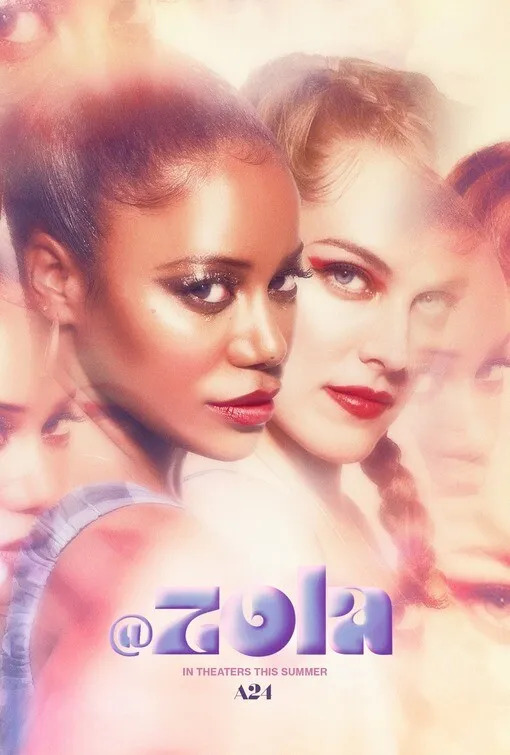
Zola is a glittering piece of postmodernism, filtering the infinite jest of touch screen technology through the medium of film. This is appropriate, considering its source material – a 148-Twitter thread from 2015. Narrated with lacerating wit by Aziah “Zola” King, the thread details the Detroit-based waitress’ wayward excursion to Tampa. Packed with suspenseful twists and turns, it's only natural that it eventually became a feature length film. After years of middling in development hell, Zola was eventually released in 2020. Directed with auteur sensibilities by Janicza Bravo, Zola uses a road-trip from hell to interrogate (or subvert) American race-relations, transaction and bodily autonomy.
The plot unfolds on the heels of a newfound friendship. Zola (the magnetic Taylour Paige) meets Stefani (Riley Keough) at her waitressing job and the two strike up a bond. Both strippers on the side, they appear to be cut from the same cloth – funny, street-smart hustlers and practitioners of a particular brand of femininity. This femininity is one patterned off of Black womanhood and Stefani, who is white, is shameless in her racial posturing. With stray braids, slicked down baby hairs and the unmistakable accent of a white girl imitating Blackness, Stefani represents a post-racial spectacle of appropriation. Keough delivers a comic tour-de-force performance, ringing each AAVE-inflect line with the appropriate amount of misplaced conviction. That Keough is the granddaughter of Elvis is not really relevant, but it does add just a pinch of subversiveness to the proceedings.

Shortly after they meet, Stefani invites Zola to strip with her in Tampa. Joining them are Stefani’s misbegotten beau (Nicholas Braun, giving a masterclass in patheticism) and her enigmatic, increasingly shady “roommate” (Colman Domingo). Zola comes to discover that she is in the throes of a trafficking scheme and that Stefani’s intentions may not be as innocent as she proclaims them to be. In her essay “Eating the Other: Desire and Resistance,” author/academic bell hooks writes of cultural appropriation and its manifestation in the media at large. She writes that, “The overriding fear is that cultural, ethnic, and racial differences will be continually commodified and offered up as new dishes to enhance the white palate – that the Other will be eaten, consumed, and forgotten.”
In many ways, Zola functions as a story of otherness – specifically White consumption of the other. Stefani is the walking embodiment of white consumption and continual exploitation/coercion of Zola only emboldens this quality. Zola, on the other hand, is expected to look out for Stefani, opining at one point, “Who’s looking out for me?” This line is indicative of Zola’s compromised safety as a Black woman – a figure who is expected to take care of everyone but herself. When Stefani tells her pimp that, “Zola made me a whole new bitch,” she is literally referring to Zola’s help in increasing her net value in the realm of sex work, but more implicity speaking her debt to Black womanhood as a means of adornment.
Zola and Stefani are depicted as mirror images of one another, both literally and figuratively. Bravo follows in the footsteps of many a psychodrama in her choice to present the two as spiritual twins. Walking down a hallway in corresponding outfits or gazing upon their reflections, they are both augmentations of one another and so completely diametrically opposed.

Elsewhere in her aforementioned essay, hooks states that, “Cultural appropriation of the Other assuages feelings of deprivation and lack that assault the psyches of radical white youth who choose to be disloyal to western civilization.” This feels like an appropriate diagnosis of Stefani, someone who exists outside of white parameters and thus adopts Blackness in relation to her perceived outsider status.
Bravo has described her films as existing a step-away from reality. This is fitting for a film like Zola, which renders a stranger-than-fiction story into filmic material. In a profile of Bravo for The New York Times author Jenna Wortham wrote:
Her movies are reminiscent of being on psychedelics — the way even the most mundane interactions become revealing, exquisite and worthy of intense examination, and the way something humorous can seem sinister for a flicker of a second before shifting back into levity. Bravo specializes in exploring the way seeing clearly can happen in an instant and permanently alter your experience of yourself and your life.
Bravo walks a tonal tightrope, but through the imaginative force of her storytelling, manages to pull it off.
Shimmering in neons and buzzing like a smartphone, Zola occupies a distinctive sonic and visual landscape. There are qualities that seem like a callback to old Hollywood: orchestral swells and grandiose title cards. These stylistic nods come across a little cheeky, especially considering the ways in which Zola rejects the Hollywood formula. Aided by playwright provocateur Jeremey O. Harris (who co-wrote the screenplay), Bravo presents a narratively frenetic fever dream that sidesteps convention at every turn. Even though Zola is unequivocally the narrator, the nature of authorial authority is subverted in a sequence where Stefani speaks to the camera, telling her side of the story.
In the Western sphere, stripping is one of the more fascinating, and literal, representations of our bodies’ entanglement with capitalism. The physicality, the need to appease and titilate, the showering of dollars. All of it seems like a particularly charged ritual of commerce. Zola does not incriminate the profession nor does it glorify it. For the titular character, the act of stripping has an autoerotic verve to it: through it she is able to explore the dimensionality of her selfhood. This is most evident in a sequence in which Zola envisions the different personas she can adopt before a performance. Repeating, “Who you gonna be tonight?,” she appears in multitudes, as if in an elaborate musical number (yet another moment that made me recall the stylistic grandeur of Old Hollywood).

If this moment is any indication, Zola is a film in which pleasure and pain are offered up with equal aplomb. It is a disorienting and spellbinding exercise in absurdism, confounded by the fact that its story is ripped from the digital headlines.
Work Cited:
bell hooks, “Eating the other: Desire and resistance.” In Black Looks: Race and Representation, pp. 21–39. Boston: South End Press, 1992.
Wortham, Jenna. “How She Transformed a Viral Twitter Thread about Sex Work into a Sinister Comedy.” The New York Times, The New York Times Company, 16 June 2021, www.nytimes.com/2021/06/16/magazine/how-she-transformed-a-viral-twitter-thread-about-sex-work-into-a-sinister-comedy.html.
@theuncannyprofessoro
12 notes
·
View notes
Text
How can the anti-capitalist themes of this film be contextualized through the sci-fi genre?
Sorry To Bother You - Roundtable Presentation
youtube
Sorry to Bother You (Boots Riley, 2018), follows Cassius Green as he begins work as a telemarketer. After months of late rent and struggling to get by, he settles for the only job that will “hire anyone”. At first, Cassius struggles to get through to anyone over the phone and is constantly being hung up on. Everything changes when he receives some advice from an older coworker, Langston. He instructs Cassius to use a “white voice” over the phone to get customers to listen to him. Langston demonstrates his ability to put on an almost cartoonish voice that immediately masks his Blackness to anyone who can’t see him. Cassius resists at first, but once he tries it there is no going back.
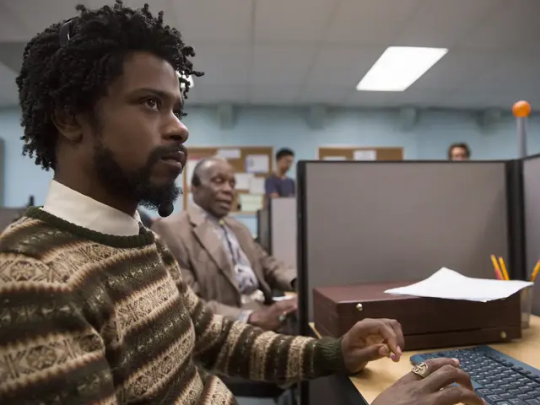
The introduction of the “white voice” is where we see the science fiction piece start to appear. The voice is completely unrealistic, clearly not the actors actually talking. It is as if their voices are being overdubbed by a squeaky overly animated white guy, and the voice is exactly the same for Cassius and Langston. Once Cassius starts succeeding at his work, his calls place him in the room with people, someone will answer the call on the toilet and suddenly Cassius is there with them, adjusting the settings on their bidet for them as he rambles about phone providers. Cassius is able to use phone to bypass his identity, creating a new imagined one through the surrealism of the film. Cassius and Langston are not just doing a voice, they are transporting themselves into another world where they escape some of the anxieties of racial identity and are able to benefit from the capitalist systems they exist within.
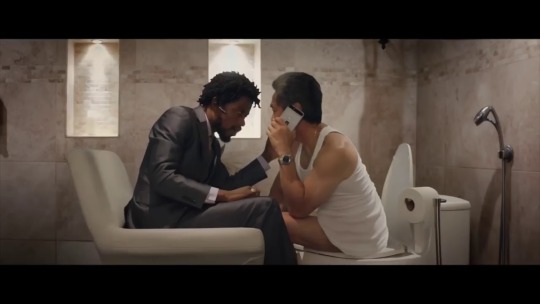
Cassius is so wrapped up in his own success that he suddenly finds himself working with his boss to create a perfectly dehumanizing workplace and against his fellow employees who are fighting for fair treatment in their field. Eventually his conscience catches up to him and he realizes he has been living in an alternate world, one that is in no way real. Sorry To Bother You presents a surrealist take on our dystopian, racist, capitalist world that makes you think about what universe you are living in.
@theuncannyprofessoro
7 notes
·
View notes
Text
How do ideas surrounding otherness in sci-fi get subverted by Araki's particular lenses.
Race in the Imaginary: Nowhere (1997) dir. Gregg Araki

"L.A. is like... nowhere. Everybody who lives here is lost. " -The opening quote of Nowhere
"In general, these films worry that the most violent and degraded acts are possible to those who do not inhabit a home or homeland." -Helen Addison Smith, "E.T. Go Home: Indigeneity, Multiculturalism and ‘Homeland’ in Contemporary Science Fiction Cinema"
Gregg Araki describes his film Nowhere as "Beverly Hills 90210" on acid. Nowhere follows a number of uniquely-named, all somewhat inter-connected teenagers (Lucifer, Dingbat, Egg, Jujyfruit...) in Los Angeles over the course of one day as they engage in an aimless cocktail of drugs, sex, polyamory, BDSM, and parties. The world of the film is in constant flux between reality and fantasy (and it is very, very, very queer). Everything is extremely heightened: there are lengthy, gratuitous sex scenes, a seemingly unlimited access to space, an abundance of drugs, and vast, artistic bedrooms that real teens would only dream of.

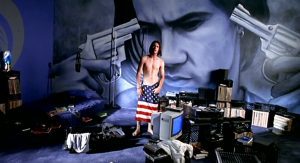
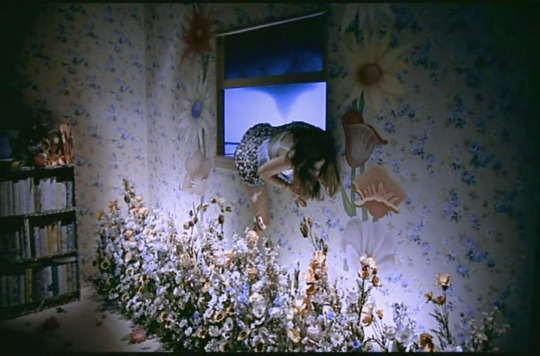
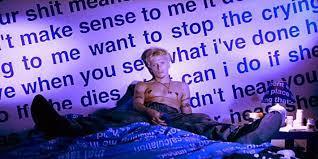
In my interpretation, the film's world is an external representation of the teens' imaginations and their feelings of an endless, indestructible youth. While this world is a step above reality for the viewer, it is real to the characters. However, this overindulgence is not without it's consequences. The first half of the film is a sort of queer, sex-positive utopia seemingly free of prejudice in which the teens can have sex with whoever they want, go wherever they want, and so on. This all seems to crumble in the second half of the film, as the teens' endless consumption unravels into overdose, sexual assault, suicide, violent fights, and broken hearts. Araki does not seem to be prudish or critical of this queer nomadic lifestyle, though. He seems to posit that this imaginative world is sadly incompatible with the "real world" of capitalist society at the turn of the century.
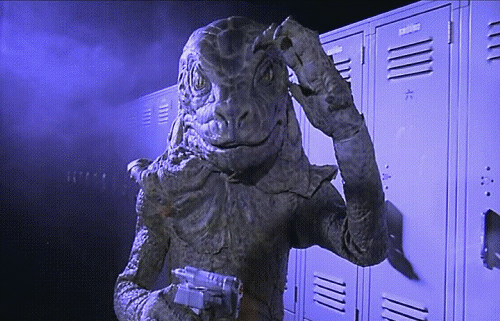
Now for the sci-fi. Unbeknownst to every character except Dark, the day on which this film takes place is sort of Judgement Day; the last "normal" day before aliens come to take over the planet.
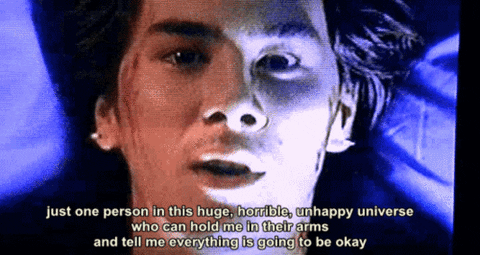
Dark is the main character of the film, and offers some narration through diary entries and videos he takes of himself and his friends. He is played by James Duvall, a multiracial actor. Dark becomes increasingly unhappier as his girlfriend Mel spends more and more time with her girlfriend Lucifer, who he hates. He grows weary of their indulgence sexually-open arrangement, simply wanting to fall in love and be committed to one person that will anchor him in a world he feels lost in. As he gets more disconnected from Mel, he finds himself infatuated with Mongomery, a boy who goes to school with the teens but who Dark knows little about.
youtube
At the same time as Dark's discontent with his lifestyle grows and he finds himself falling in love with Montgomery, he sees a bunch of giant alien creatures roaming around the city, abducting people. Dark is the only character able to see these aliens, which seems to be no coincidence alongside the fact that he is the only character verbalizing any anxiety about the future and the teens' lifestyle. In one diary entry, he says: "I feel like I’m sinking deeper and deeper into quicksand, watching everyone around me die a slow, agonizing death. It’s like we all know, way down in our souls, that our generation is gonna witness the end of everything. You can see it in our eyes."
In the final scene of the film, Dark returns home after an empty night of partying and a fight with Mel. Montgomery appears at his window and tells Dark that he was abducted and tested on by the aliens. The two boys lie together on Dark's bed and confess their love, promising to never leave each other. Just when it seems like Dark has found what he has been longing for, Montgomery goes into a violent coughing fit and explodes, leaving a bug-like alien in his place that crawls out of Dark's room, and the movie ends.
youtube
While the aliens in Nowhere are not necessarily representative of a racialized Other according Addison Smith's analysis of Sci-Fi films, the impending doom of an alien invasion and Dark's isolating anxiety is quite in line with Addison-Smith's reading of home and homeland. Araki's identity as Japanese-American director and Duvall's as a multiracial American actor are factors in this reading of the film. Since this film is thus told from a mixed/multiracial perspective, the its anxiety is not surrounding the (white/Western) fear of "losing" a home to outsiders, but the fear of not belonging to any one home in the first place.
Addison-Smith writes:
"For many people in self-avowedly multicultural nations such as the United States, their status as migrants, be it forced or economic, recent or later generational, means that 'home’ has become a complex, multiple and sometimes fraught notion. That such multiple belongings to place is not confined to recent migrants can most immediately be seen in the labelling of many ethnic groups through the joining of two place names (African—AmericanJapanese-American)" (28).
Araki uses Los Angeles as an unstable home in this film (note the opening quote at the top of this post). He plays upon the notions of transplants to the city, and the stereotypes that the city and its inhabitants are vain and superficial. The characters move throughout the city at will, with no connection to any particular space. Actual homes are places of confinement and depression (both the suicides in the film occur in character's bedrooms).
I read that Dark's ability to see the aliens is a representation of his sense of displacement and anxiety for the future. When Montgomery enters his room and the two share an extremely intimate, tender moment, his room finally begins to feel like home, rather than its previous role as a space for his lonesome brooding and masturbation. But when Montgomery explodes as is replaced by an alien, Dark's vision of home and someone to share it with also figuratively blows up in his face; home feels impossible.
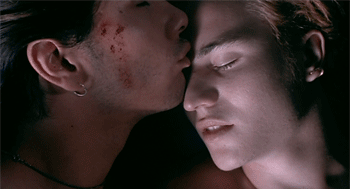
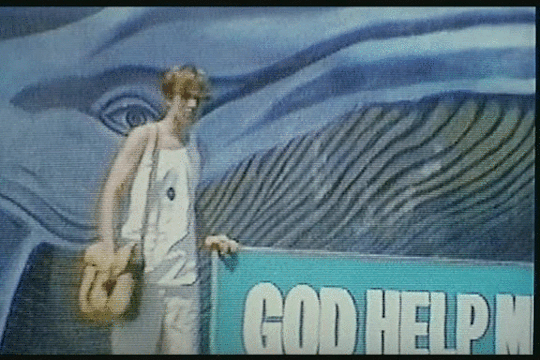
Finally, Montgomery's objectification by Dark's infatuation and his identity as a white queer man seem to be an inversion of both romance and Sci-Fi tropes. Montgomery seems to occupy both the role of the "Manic Pixie Dream Girl" in Dark's desire to be saved by him, and the racialized alien Other in his mysteriousness and his constant affiliation with the aliens. Addison-Smith writes, "An alien is easy to identify, and particular judgements about them are thus easily drawn from their appearance alone, so rooting their ‘racial nature' in their biology" (27). Montgomery definitely stands out in this world. He has different colored eyes, is always dressed in white, appears to Dark miraculously by a sign that reads "God help me," and, unlike very other character, is quiet and keeps to himself. He is alien and even an angelic figure to Dark, a unique representation against Addison-Smith's notions of the racialized alien as either invader or teacher.
The entire movie Nowhere is on Youtube! I think it's really great, but there's a ton of trigger warnings (sexual assault, drug abuse, suicide, eating disorders, physical assault, gore). The quality is also very bad. Proceed with caution.
youtube
19 notes
·
View notes
Text
Is there ways in which France's history of colonial violence has informed the oppressive conditions that play out in this film?
La Planète Sauvage (1973) Race in the Imaginary
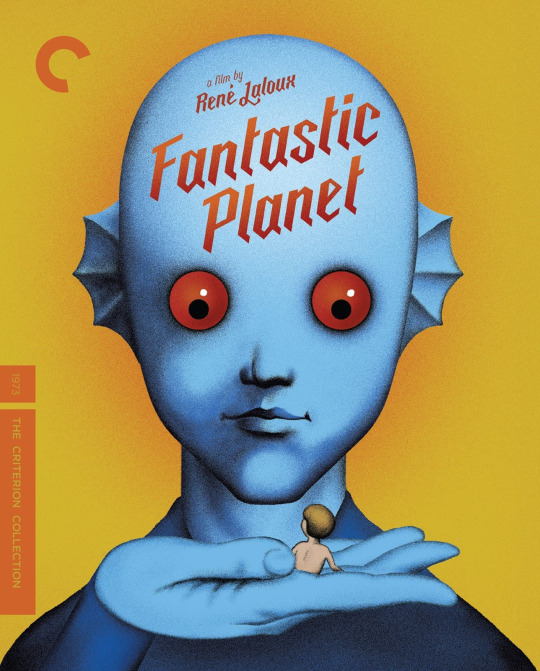
René Laloux’s La Planète Sauvage (1973), an experimental animated science fiction art film, is as strange as it is dense with implications. The politically charged dissonance of psychedelia combined with the film’s Dali-esque surreal cutout stop-motion animation universe, realized by French avant-garde artist Roland Topor, has solidified this film as a seminal work of animation and a cult science fiction feature. The film is set in the hallucinatory landscape of the planet Ygam, where gargantuan blue humanoid creatures called Draags who rule the planet enslave humans (called Oms–a play on the French homme)--Terr, an Om who has been kept as a pet since Traag children killed his mother in his infancy escapes from his child captor and bands together with a band of radical escaped Oms to resist the Draag regime and impending genocide. The film is markedly allegorical for its use of imagined alienness to establish otherness and marginalization, and the techniques the Draag use to subordinate the Oms evoke historically significant racist discriminatory practices. Simply, it feels like a movie that is bluntly about something beyond what it appears to be, and the slight heavy-handedness of its messaging reifies its goal of engaging in racial discourse.

The racial politics of Fantastic Planet are strange in that the broadness of the trenchant sociopolitical commentary imminent in the dynamic between oppressor and oppressed has led critics to draw comparisons between the plot and the narrative around “animal rights” and the (mis)treatment of domesticated animals, yet the human-ness stitched into the film’s fabric positions it as a text specifically interested in the ways humans create divisions among themselves. The Draags and the Oms, despite their vast difference in physical size, do resemble one another and take on different forms of the corporality of a human being, and for this reason and many others, Fantastic Planet seems to be a film about how we could recognize ourselves in one another and still splinter into factions and enforce senseless violent domination.
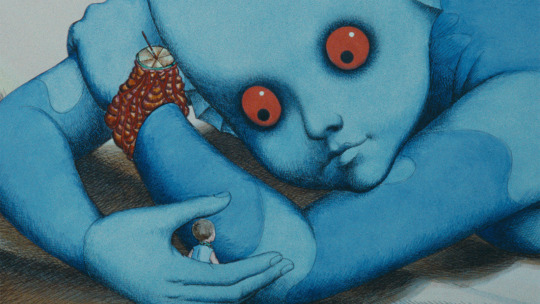
Terr’s captor, a girl named Tiwa, has given him a collar to control him as he attends “school” with her, which involves her wearing a headset that transmits facts into her brain, and a defect in his collar inadvertently allows him to learn the same knowledge as Terr, knowledge he ends up using to save the Oms. Intelligence is the gateway to capital in Ygam and the Draags are highly intellectualized beings who pride themselves on their inborn wisdom and biological superiority that allows them to far outdo the meager Oms in their knowledge–the film comments on the complications of the racialized bioessentialist understanding of knowledge that would posit that being smart, and subsequently having value, is a fixed innate biological trait. The Oms navigate the world through cunning, outwitting the Draags practically in ways they might fail to do so intellectually and the Draags and Oms counter one another in the film on what “counts” as knowledge: the Draags favor transcendental meditative practices that imbue them with highly complex perspicuity, whereas the Oms argue that their knowledge is more useful for the ways it enables them to survive despite their circumstances. The Oms are made alien not only through their physical inferiority but also because they exist in a society that was not built for them. Fantastic Planet depicts an idea of home that is stringent upon exclusivity and requires technical superiority to belong; shoring up racial politics, Fantastic Planet deploys a social constructionist standpoint that colors these divisions as the products of structural forces benefitting only those who erected them.
youtube
18 notes
·
View notes
Text
Do you think the radiation poisoning could be likened to environmental racism or is that too much of a stretch?
Roundtable 2: Race in the Imaginary and Mad Max: Fury Road (2015)
youtube
Mad Max: Fury Road is a 2015 film by George Miller that many hail as a feminist manifesto. It’s set in a barren wasteland, supposedly the not-too-distant future after the Water Wars and the depletion of oil. It follows Max after he’s captured by Immortan Joe’s War Boys and Furiosa’s attempt to flee and free Immortan Joe’s wives. It involves endless perfectly edited practical car chases, Nicholas Holt in so much makeup you can’t recognize him, and simply named characters and places like the “Bullet Farm” and “War Boys.”
It is clear from the very beginning that Immortan Joe is evil: his first scene involves close-ups of his battered and radiation-poisoned body. He is the alien because, according to Helen Addison-Smith's article, an “alien is easy to identify, and particular judgments about them are thus easily drawn from their appearance alone” (27). Several members of his “team,” like his son Corpus Colossus or The People Eater, also have emphasis put on their atypical bodies. Max and Furiosa, on the other hand, are not aliens: they’re conventionally attractive, able-bodied, recognizable humans. While Furiosa is missing her left forearm, she has a mechanical prosthetic and there is no attention drawn to this. Through the lens of Addison-Smith's article, it could be argued that Miller uses atypical bodies to signify alien- and otherness.
youtube
Another very important point to bring up is the setting of this film. Though never explicitly stated, it is set in the Australian outback, a country that is home to Aboriginal and Torres Strait Islander populations and was stolen by the British. As far as I know, Courtney Eaton (Cheedo the Fragile), whose mother is of of Chinese, Cook Island and Māori descent, is the only indigenous actor in the film. Addison-Smith addresses this phenomenon, writing that “The diasporic subject has a sense of belonging to a place where [they do] not live … it ‘is the myth of the (lost or idealized) homeland, the object of both collective memory and of desire and attachment, which is constitutive to diasporas’” (28). A large part of the film’s plot is Furiosa and The Wives returning to Furiosa’s “homeland”: The Green Place, home to the Many Mothers. But, for the most part, none of this land belongs to any of the characters in the film – they do not have a right to it and, at the end of the day, they caused the apocalypse that landed them in the Outback fighting for their lives.
@theuncannyprofessoro
7 notes
·
View notes
Text
How do you think the race of the two leads factors into the contents of the film?
Men in Black (1997)
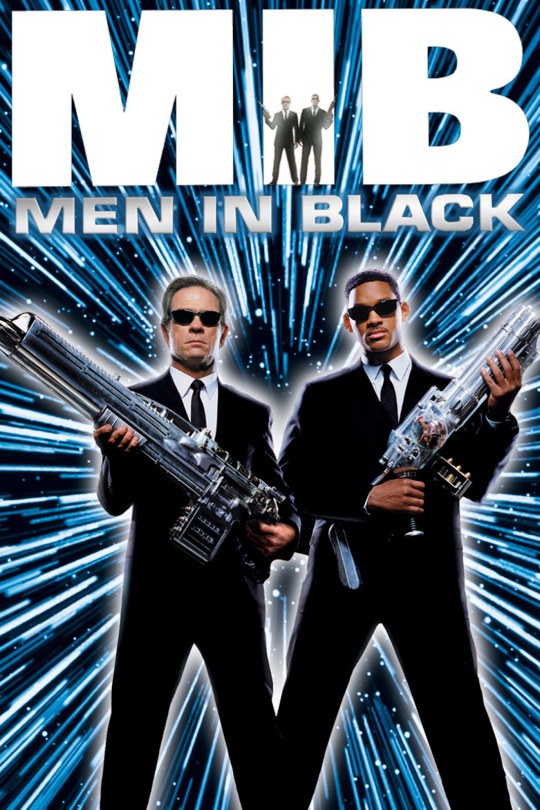
Men in Black details Agent J’s first mission for the eponymous government agency who regulates alien activities such as the immigration of said aliens to Earth and any threats they may pose. Agent J and his mentor, Agent K, remedy an alien diplomatic crisis and prevent the disintegration of Earth.
youtube
In Men in Black, many aliens pass for humans and have adopted disguises to help them live among humans. However, many of them still have their alien features that set them apart from the human population ranging from double pupils with gills, regenerative limbs, animalistic features, or being miniscule. Once revealed to be alien, however, it is impossible to unsee them as aliens and there is an uneasy horrificness at these strange creatures.
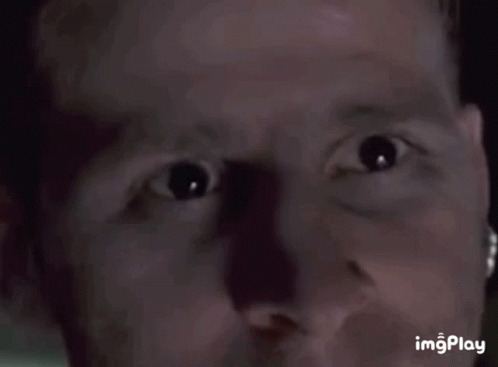
The main antagonist is a newly landed alien who is portrayed as quite volatile and hostile towards all humans. His species is literally referred to as “bugs.” He adopts a human skin that gruesomely decays throughout the movie and at the end, reveals his true appearance which is of a monstrous, huge cockroach like creature. This is the main alien that is consistently shown throughout the movie despite their depiction of other aliens as overall helpful, intellectual, and peaceful refugees. As a result, the audience focuses on the evilness and non belonging of aliens. This is similar to the typical reactions towards immigrants because current residents are not welcoming to new people especially people of color who are deemed not worthy of a place in the community as they are disgusting or contaminating (like the alien protagonist) and would ruin their current balance.
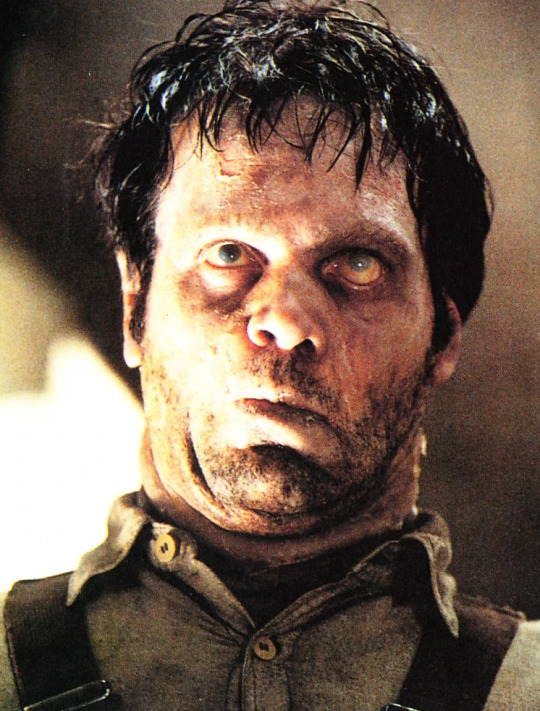

Citizens are also scared of immigrants having the same privileges and opportunities as them or even succeeding more than them, thus endangering their own chances which also applies to the aliens in the film. Most of the film’s aliens pass for humans which would freak out Earth’s human citizens as they are being threatened by these new unexpected populations. The Men in Black agency actually already has limited these aliens' success as the agency profits off the technology they confiscate (steal) from the aliens like Velcro. This is representative of how it is the aliens “teachings rather than their continued presence that is vital” especially because Earth is doing them a favor by providing the aliens refuge (Addison-Smith 31). The emphasis of the aliens seeking refuge on Earth is also an example of how the aliens are homelessness and have to rely on New York and its multiculturalism to blend in and survive. However, they are not completely at home and secure. Like human immigrants in our society, they have to build new lives in their new world due to their escape from their legitimate homeland and have to assimilate to the new society and current residents.

In addition to this migration and passing of aliens as humans (akin to racial passing), Men in Black explores alien invasion and how aliens can lead to the downfall of the very planet that protected them. Firstly, the whole crisis is caused by an unsanctioned alien who landed and started wreaking havoc the moment it got to Earth. This causes an alien species ship to come to destroy Earth, even though Earth was a refuge for one of their royalty. Throughout the film, there are also many aliens who have decided to flee Earth because of its impending doom and leave it to be destroyed even though it was a safe haven for them as refugees. This mirrors the uncertainty of the loyalty of immigrants to their new home or rather their self-preservation or old motherlands. However, it is understood because, like immigrants, aliens “are always overwhelmed numerically by humans” (Addison-Smith 32). As seen in the Men in Black agency, aliens are not in any leadership positions. The majority of the aliens who help the agency are treated very hostilely in return for their services and intel. Aliens are mistreated by the only human group that knows of their existence and could validate that existence. The aliens in Men in Black reflect the opinions of immigrants and refugees in regards to how their differences, their lack of belonging in their new land, and the lack of human empathy is emphasized.
@theuncannyprofessoro
9 notes
·
View notes
Text
it seems like this film subverts/lampoons stereotypes. how does this play into its place within the sci-fi genre, which has historically been occupied by white bodies?
They Cloned Tyrone

They Cloned Tyrone is a sci-fi mystery drama that follows the story of a drug dealer named Fontaine, who discovers a shocking conspiracy that his entire neighborhood is a part of. Starring John Boyega as Fountaine, Teyonah Parris as a sex worker, Yo-Yo, and Jamie Foxx as a pimp named Slick Charles, the film follows Fountaine and the gang as they try to figure out the truth while finding themselves sinking deeper into the rabbit hole of lies and secrets spread farther than they’d imagined. Fountaine, who was shot in a drive by shooting, came back the next day as if nothing had happened. Slick is shocked because he saw them murder him and immediately knows something is up. When they go to get Yo-Yo's help, they are led to an abandoned house where they find an underground lab where these scientist are running human cloning experiments. This is where they find Fountaine's dead body, the one that Slick had seen the day before.

Fountaine realizes that he is a clone and that the government is surveilling all of Glen, the fictional town in which they live. Slick finds a white powder in the lab which he figures out if being put in the chicken they eat, the hair relaxer at the salon, and in the juice they give out at the communion. Along with this, the music is also a factor of hypnotism against the black community.
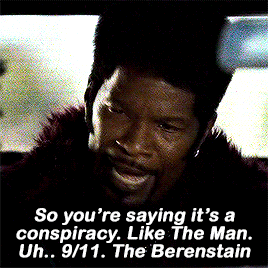
In the end it is revealed that the government has made clones of most people in the community of Glen, specifically people like Fountaine and Slick, who are drug dealers and pimps, in order to damage the well being of the people. It is revealed that these simulations are running in multiple cities around the U.S. including L.A, Chicago, and Detroit(all cities with majority Black populations). The ending shows that Fontaine, Yo-yo, and Slick are nowhere near finishing what they started. The movie deals with topics such as free will, community, and personal responsibility. They indirectly address issues that the government has set up against the black community, such as gentrification, the crack epidemic, and police brutality.
10 notes
·
View notes
Text
given that this film is set in south london, to what extent is race explicitly mentioned?
Roundtable 2: Race in the Imaginary and Attack The Block (2011)
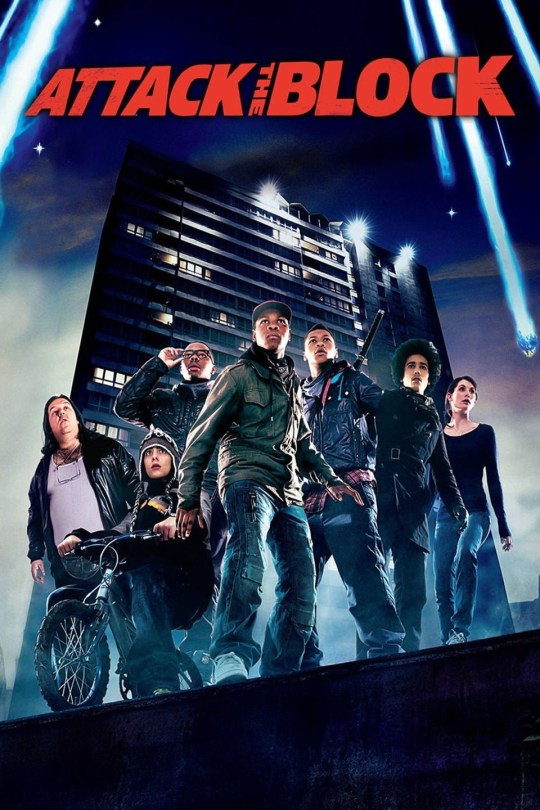
youtube
Attack The Block (2011), directed by Joe Cornish, is a sci-fi film that takes place in South London, and follows a group of trouble-making teenagers who must defend themselves and their apartment complex from extraterrestrial beings. The film begins with the group of teenagers attempting to rob an innocent woman, but their attempt is cut short when something falls from the sky, and lands in a nearby car. Once the woman runs off, the boys go to investigate the car, and stumble upon an alien creature who lunges at them. Originally, it seemed as if the villains were the teenagers, however the landing of the alien establishes the real danger of the story. After they take off the bandanas they had obscuring their faces, and we get a glimpse at their comradery, it's obvious that they are just children.
The boys' failed robbery from the beginning comes back to haunt them, as the woman, Sam, contacts the police to find them. Now, not only does the group have to run from aliens, but the police as well. As the group runs for their lives from aliens, two police officers manage to grab hold of the group's "leader", Moses, played by John Boyega. This is one of many times that the police chase after them, as if they are the aliens, rather than catching the actual aliens that are killing civilians. Here, a comment is being made on the fact that teenage boys of color, specifically Black boys are disproportionally sought after by law enforcement. Moses even goes, to say "I reckon, the Feds sent them anyway. Government probably bred those things to kill black boys. First they sent in drugs, then they sent guns and now they're sending monsters in to kill us”, showing that even in a world where rampaged aliens are killing humans, children of color are seen as the threat.

Most of the film takes place inside, or just outside of a giant housing project in South London, known as, “The Block”. We learn that this is where almost all of the boys live, and a place they feel is their duty to protect, often stating "nobody fucks with Block"(7:09). The building is akin to an eery, futuristic fortress, however it is a clear home for the boys. Though the boys have different personalities, and we get brief glimpses into their differing home lives, The Block marks a universal place of belonging for them. A place where identity is characterized by protecting one another from the impending threats of aliens and law enforcement, both of which have no regard for the boys as people. Though they are seen merely as thugs by law enforcement, the movie works to bring humility to them through giving depth to their personalities, and addressing the socioeconomic context of their lives.
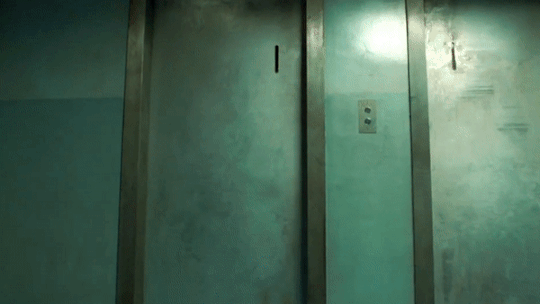
11 notes
·
View notes
Text
you've referred to the influence of the Rodney King riots -- do you think there are other cultural forces specific to the 90s that influenced this film?
Strange Days (Kathryn Bigelow, 1995)

Strange Days (Kathryn Bigelow, 1995) is a science fiction thriller set in Los Angeles during the last two days of 1999. With the general consensus being that the end of the world is imminent: Los Angeles has devolved into a warzone of debauchery, violence, and crime. The film centers around ex-cop Lenny, who deals SQUID devices on the black market. SQUIDS are illegal devices that record peoples’ physical sensations and memories from their cerebral cortex onto a mini CD disc that allows them to be played back and experienced by anyone.
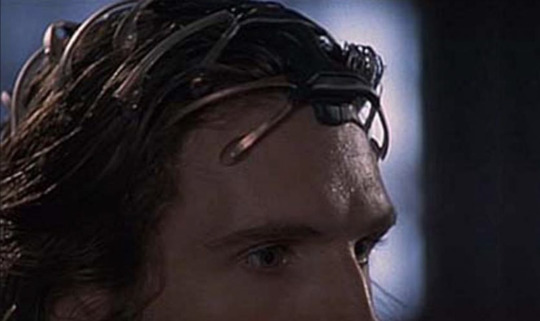
Lenny’s ex-girlfriend Faith’s friend Iris ends up recording police murdering black rapper and activist Jeriko One. The audience has only briefly been introduced to Jeriko via a speech he gives on television protesting the police state that Los Angeles has fallen into and pushing for peace. Since Jeriko’s character is not further developed before he is killed, he exists as more of a symbolic placeholder for all of the innocent black people that police have murdered. Iris is then chased by police but ends up getting the tape to Lenny before she is brutally raped and murdered. Lenny and his driver/bodyguard/friend Mace (who is also in love with him) then have to run from everyone who’s trying to kill them and Mace gets the tape of the murder to the police commissioner.
It’s interesting that even in this apocalyptic, end-of-the-world setting, racially motivated violence and police brutality are still prominent. Bigelow has discussed in interviews being motivated to begin production following impactful incidents in the 90’s such as the Lorena Bobbit trial and the Rodney King verdict and the riots that followed in 1992. Multiple of the characters in Strange Days are overtly racist (ie. the cops/murderers), but more subtle racism also permeates throughout. When trying to figure out how to get the video of Jeriko’s murder to the public, Mace and Lenny go to Lenny’s “friend” Max (who will turn out to be an awful person) for help. Max says simply that Lenny and Mace should not show the tape because there will be riots. In this moment Max is willing to silence the story of police murdering a black man to avoid causing a more than warranted uprising.
Bigelow seems to have intentionally sought to explore the intersection between race and gender as she stated that she created Mace’s character to examine "valuable connections between female victimisation and racial oppression." Mace proves to be stronger and more confident than Lenny; she repeatedly saves their lives and gets them out of tricky situations, yet she is still reduced to the role of his bodyguard/driver, and not given much of a story outside of Lenny’s world. At one point when they are in the car, she points out this dynamic saying “driving Mr. Lenny,” a reference to the film Driving Ms. Daisy (Bruce Beresford, 1989). Mace is additionally in love with Lenny because he stepped in and helped her take care of her son when the kid’s father was no longer around. Despite Mace being a strong, smart, and badass, black woman, her story is somewhat reduced to being the white man’s sidekick. She is also in love with Lenny for the entire film and when they eventually kiss at the end, it feels like she has now only existed to be his love interest.
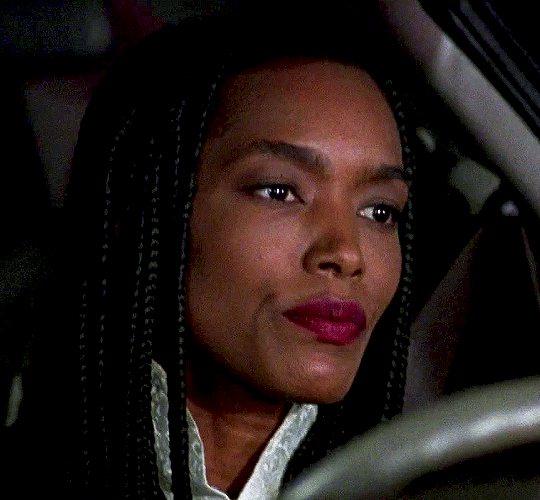
11 notes
·
View notes
Text
How much do you think the colonial history of South Africa influenced this film?
District 9
youtube
"District 9" is set in an alternate version of Johannesburg, where a massive alien spacecraft hovers above the city. The extraterrestrial occupants, known derogatorily as "Prawns," are resettled into a government-controlled district. The narrative centers around Wikus, a bureaucratic functionary assigned to oversee the forced relocation of the aliens. When a mysterious alien substance alters Wikus's biology, he becomes a target for both the government and the aliens. Fleeing to the district he once oversaw, Wikus forms an uneasy alliance with an intelligent alien named Christopher Johnson.
How does the film use human technologies and/or imagined alienness to establish different identities?
The film employs a pseudo-documentary style, blending real-world news footage with filmmaking. The human technologies, such as military weaponry and surveillance equipment, highlight the power dynamics between humans and aliens. The alien technology, on the other hand, is portrayed as highly advanced and mysterious, emphasizing the contrast between the two species.
The imagined alienness is crucial in shaping the narrative's socio-political commentary. The physical appearance of the aliens, resembling insect-like creatures, contributes to their dehumanization. This visual otherness reinforces the xenophobic attitudes prevalent in the film's fictional world, drawing parallels to real-world issues of racism and discrimination.
How does film de-individualize and/or biologically reify alien characters that mimic racial prejudicial and discriminatory practices?
The film de-individualizes the alien characters through various means. Firstly, the aliens are collectively labeled as "Prawns," stripping them of individual identities and reducing them to a derogatory, dehumanizing term. Secondly, their living conditions in the segregated district contribute to their de-individualization, as they are confined to shantytowns, reinforcing a sense of collective suffering.
In what ways does the film depict home for the characters?
For the humans, Johannesburg represents their home, and the arrival of the aliens disrupts this sense of familiarity. The district where the aliens are confined becomes a physical manifestation of their displacement, a makeshift home reflecting their marginalized status.
How does technology inform definitions of home/land, indigenes, and aliens?
The powerful human military technology reinforces the idea of humans as the dominant kind, asserting control over the land. The alien ship, initially a symbol of hope for the aliens' return home, becomes a source of conflict as they all vie for control.
The film suggests that technology, whether human or alien, is a double-edged sword that can be both a tool for empowerment and a catalyst for conflict. The question of who controls the technology becomes central to the characters' struggles for autonomy and a sense of home.
In what ways do the character relations reflect anxieties of racial identity, racial mixing and/or passing, migration, and invasion and/or colonization?
The segregation of the aliens in a specific district echoes the forced segregation of racial groups in apartheid-era South Africa. The relationship between the human protagonist, Wikus Van De Merwe, and the alien Christopher Johnson challenges preconceived notions about racial identity and cooperation.
Wikus undergoes a physical transformation that blurs the lines between human and alien, reflecting the film's exploration of the fluidity and constructed nature of racial identities. The tensions between humans and aliens also mirror historical anxieties about invasion, colonization, and the fear of the unknown "other."
9 notes
·
View notes
Text
Roundtable Queries: Race in the Imaginary, Born in Flames (1983)
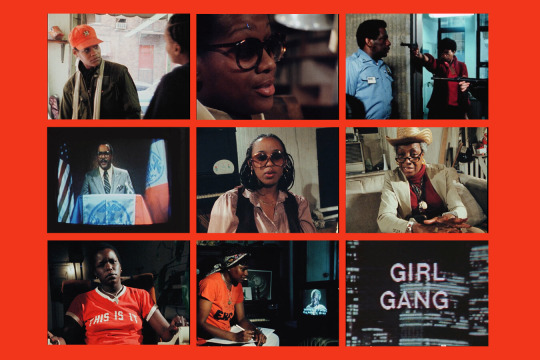
How does the film use human technologies and/or imagined alienness to establish different identities?
In spite of taking place in a dystopian future, there is no explicit depiction of advanced technologies. Born in Flames is set ten years after a peaceful revolution that has rendered America a Democratic socialist state. This supposed stride in progress has not stopped the oppressed from being marginalized. As a response to their oppressive conditions, a group of women-led community organizers take matters into their own hands with increasingly radical approaches. Writer-director Lizzie Borden's vision of the future suggests that dystopia might not be too different from present-day society.
youtube
How does film de-individualize and/or biologically reify alien characters that mimic racial prejudicial and discriminatory practices?
There are no aliens in this film, but alien identity is certainly a central theme. Women themselves are presented as somewhat alien in the ways they have been ostracized/signaled out as other. One such example is women being fired on the basis of sex. Different forms of labor are depicted from secretarial work to construction, showing the ways in which identity can be informed by one's contribution to capitalism (even if it has been repackaged as socialism).
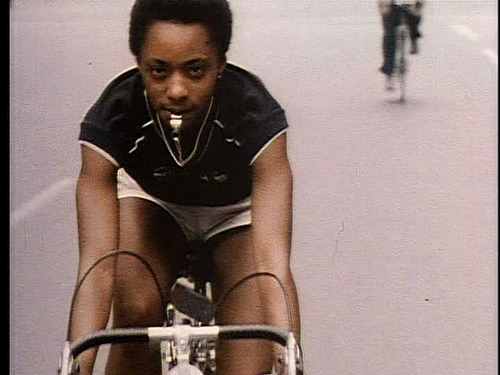
In what ways does the film depict home for the characters?
Home is shown through varying New York apartments. Outside of the tumultuous cityscape, these are places of respite. Food is served, community is engaged with, friendships are formed. I was reminded of multi-disciplinary artist Carrie Mae Weems' "Kitchen Table Series," which featured photographs of Black women in varying tableaus. Within Weems and Bordens visual landscapes, kitchens are portrayed as emblems of intimacy and identity.
How does technology inform definitions of home/land, indigenes, and aliens?
As I stated earlier, futuristic technology does not factor much into this particular film. That said, television/radio broadcasting are used to relay messages of political ideology and statehood. In one sequence, a women's group breaks into a news station and holds employees at gunpoint until they play a message about a Black community organizer who mysteriously died in prison. Born in Flames shows the power of mass media as a form of control and resistance.

In what ways do the character relations reflect anxieties of racial identity, racial mixing and/or passing, migration, and invasion and/or colonization?
As a magnum opus on intersectional feminism (before the term was coined), much of the film concerns the cultural forces that separate different groups of women. There is a group of white, female journalists who decry the "separatist" actions of more radical groups. In the end, it is unity amongst women that is the enactor of change, signaling a present-day call to action as broadcast from Borden's not so distant future.
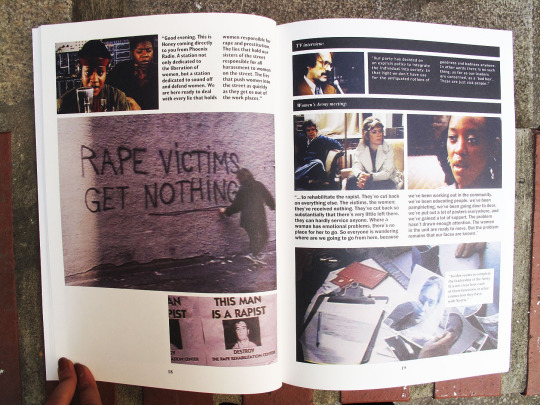
@theuncannyprofessoro
10 notes
·
View notes
Text
Roundtable Queries: Race in the Imaginary, Born in Flames (1983)

How does the film use human technologies and/or imagined alienness to establish different identities?
In spite of taking place in a dystopian future, there is no explicit depiction of advanced technologies. Born in Flames is set ten years after a peaceful revolution that has rendered America a Democratic socialist state. This supposed stride in progress has not stopped the oppressed from being marginalized. As a response to their oppressive conditions, a group of women-led community organizers take matters into their own hands with increasingly radical approaches. Writer-director Lizzie Borden's vision of the future suggests that dystopia might not be too different from present-day society.
youtube
How does film de-individualize and/or biologically reify alien characters that mimic racial prejudicial and discriminatory practices?
There are no aliens in this film, but alien identity is certainly a central theme. Women themselves are presented as somewhat alien in the ways they have been ostracized/signaled out as other. One such example is women being fired on the basis of sex. Different forms of labor are depicted from secretarial work to construction, showing the ways in which identity can be informed by one's contribution to capitalism (even if it has been repackaged as socialism).

In what ways does the film depict home for the characters?
Home is shown through varying New York apartments. Outside of the tumultuous cityscape, these are places of respite. Food is served, community is engaged with, friendships are formed. I was reminded of multi-disciplinary artist Carrie Mae Weems' "Kitchen Table Series," which featured photographs of Black women in varying tableaus. Within Weems and Bordens visual landscapes, kitchens are portrayed as emblems of intimacy and identity.
How does technology inform definitions of home/land, indigenes, and aliens?
As I stated earlier, futuristic technology does not factor much into this particular film. That said, television/radio broadcasting are used to relay messages of political ideology and statehood. In one sequence, a women's group breaks into a news station and holds employees at gunpoint until they play a message about a Black community organizer who mysteriously died in prison. Born in Flames shows the power of mass media as a form of control and resistance.

In what ways do the character relations reflect anxieties of racial identity, racial mixing and/or passing, migration, and invasion and/or colonization?
As a magnum opus on intersectional feminism (before the term was coined), much of the film concerns the cultural forces that separate different groups of women. There is a group of white, female journalists who decry the "separatist" actions of more radical groups. In the end, it is unity amongst women that is the enactor of change, signaling a present-day call to action as broadcast from Borden's not so distant future.

@theuncannyprofessoro
10 notes
·
View notes
Text
Mississippi Masala's contrasting use of romance and friendship to speak on interracial dynamics was a particularly gripping storytelling device. I feel this was compounded by such relations taking place many years apart, showing how history has both changed and remained stagnant.
Mississippi Masala Viewing Response
Mira Nair’s Mississippi Masala depicts multiracial companionship through both a platonic friendship and an intimate relationship. An important scene from this film occurs after Demetrius and Mina’s forced split, when Demetrius confronts Mina’s father by saying, “I know that you and your daughter ain’t nothing but a few shades from this right here [pointing to his own face]. That I know.” Reddy explains that Demetrius, as a black man, saying Jay’s skin, as an Indian man, is only a few shades lighter than his own echoes Jay’s explanation to Mina that the difference in skin color between black people and Asian people is the root of his racial “pain”. Mina’s family was displaced in 1972 from Uganda during a time of political and economic turmoil between black Africans and Asians living in Africa. Her father’s best friend, Okelo, told him that Africa was just a place for black Africans and that he must leave, although Jay had lived there his entire life as an ethnically Indian man. Jay explains to Demetrius that he does not want Mina to go through the same racial struggles that he did, and it can be understood that his displacement from Uganda deeply affected him. Ultimately, Jay returns to Uganda and sadly discovers the news of Okelo’s death shortly after he had left eighteen years prior. The film ends on a lighter note with Jay finding peace back in the country where he was raised.

2 notes
·
View notes
Text
I think Okelo is one of the most interesting characters in this film, in part because of his evolving relationship to Blackness and how this has been colored by history. I was particularly moved by the final scene where he returns to Uganda as I felt it represented a moment of cultural understanding after years of anguish.
Mississippi Masala
In this film, Mina and her family along with countless Indian families are expelled from Uganda under the orders of the ne Ugandan dictator. They ultimately end up in Mississippi where Mina meets and falls in love with Demetrius, a Black carpenter. Their love is quickly found out, causing controversy in their small community. Mina's family is judged by other Indian families in the community for her relations with a Black man, Demetrius loses business as his white and Indian customers have boycotted him. Ultimately they decide to run away together, to form their future together without relying on their families that have heavily protested against them expressing their love. The underlying issues of race relations, in this case Afro-Asian relationships, is evident in the sentiments of Mina's father, Jay, who felt extremely betrayed when he was ousted from Uganda, the only place he considered home. He felt as if his childhood best friend, Okelo, had betrayed him by suggesting he move his family from Uganda. Where else could he go, he was born in Uganda, he has no connection to India even if he is ethically Indian. We know from Demetrius' brother that this is exactly how African Americans feel, although ethnically from Africa, they have to ties with that continent after decades of displacement. However Okelo's 'betrayal' permanently affects Jay's perception and acceptance of Afro-Asian relations as he is extremely against Mina and Demetrius' relationship, assuming that Demetrius will eventually betray his daughter. Upon returning to Uganda, Jay finds out that Okelo had been possibly murdered for defending Asian teacher's jobs in Uganda--he ultimately regrets all these years of detesting him. Mina and Demetrius' relationship offers us a chance to learn form the mistakes Jay and Okelo's relationship had went through

1 note
·
View note